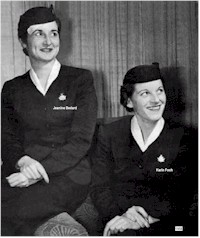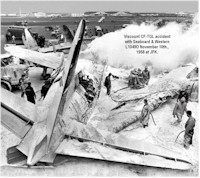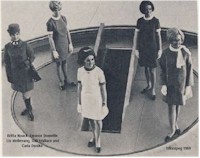|
Ken Pickford explains the reason CP operated 3 DC-10-10's aircraft with Americican registrations- I can add further details re Wayne's reference to the 3 United Airlines DC-10s operated by CP from 1983 to 1987 (Fins 334/336/337). United had just been awarded nonstop traffic rights between Seattle and Hong Kong but had no aircraft in their huge fleet then with enough range to operate the route. So they made a deal with CP Air to lease 3 of CP's long-range DC-10-30s temporarily and replace them with 3 of United's shorter-range domestic model DC-10-10s. The 3 UA DC-10s were mainly used on CP transcon domestic routes as well as some shorter transatlantic routes such as Toronto-Amsterdam. If memory correct they were also used on Toronto-Lima, Peru. Longer international routes required the range of the DC-10-30. The 3 CP DC-10-30s that went to UA during those 3 or 4 years were C-GCPF/G/H They operated with Canadian registration while with UA and the UA DC-10-10s kept their US registrations while with CP. By 1987 United had acquired some long range 747-200s and the DC-10-30s were returned to CP and the UA DC-10-10s being operated by CP went back to UA. Interestingly, that Seattle-Hong Kong route (later dropped) was only United's second longhaul international route after Seattle-Tokyo which had started a year or so earlier. Their early-model 747-100s were adequate for that route but lacked the range for SEA-HKG. Until those two routes started, United's only other international routes had been Seattle-Vancouver (their first international route in 1934) and Chicago-Toronto which started around 1967. UA added many more international routes in 1986 when they acquired Pan Am's entire transpacific route network when Pan Am was in desperate financial shape and was selling off their most valuable assets.. I recall hearing that many CP flight attendants didn't like working on those 3 UA DC-10-10s as, like most other early domestic model DC-10s, they had the galley on the lower deck (using what would normally be part of the cargo/baggage compartment). One or two flight attendants had to work down there and everything had to be sent up to the passenger deck on elevators, so the meal service procedures on those aircraft were quite different than on CP's own DC-10-30s which had the galleys on the main deck. |
|
Ken also sent us these comments referring to NetLetter nr 1342 – 1. The last name of the CP sales manager for Scandinavia mentioned in the caption of the travel trade show photo should read "Timmermann" (not "Tianmermann"). |
|
Female curiosity paid off for stewardesses Jeanine Bedard, left, and Karin Foch when then Viscount they were preparing for passengers was rammed on the tarmac at Idlewild Airport, New York, by another aircraft, out of control. The girls, who escaped without injury, received 15 letters of congratulations from 10th grade students of a French school in Montreal. The letters were written as a homework assignment in English. Click here for the official accident report. Related excerpts: The second one includes the names of the two "stewardesses" as they were of course known at the time. After leaving the runway the aircraft crossed a taxi-way and two perimeter strips, and entered a position on the terminal parking area where it collided with a Trans-Canada Air Lines Viscount, CF-TGL. The Viscount was standing at Gate 5 and was to have boarded its passengers for a scheduled departure within a few minutes of the accident. Stewardesses J. Bedard and K. Foch on board the Viscount, alerted by the cries of persons on the ramp and the noise of the approaching Constellation, departed their aircraft as rapidly as possible. The Constellation crew left their aircraft by jumping from the main cabin door which was approximately four feet above ground level. Fire-fighting personnel had already arrived at the scene and were directing a coverage of foam toward this exit at the time. Both aircraft were virtually destroyed by fire. Regards, Ken |
|
|
|
Norman Hogwood, after reading the story of the Lancaster recovery in "Alan's Space" NetLetter nr 1342, sent us this story - That was an astonishing feat. I can imagine they had some very anxious moments during the tow, especially as they towed using the main gears with, presumably, no braking assistance from the cockpit and even if there was some sort of help from that quarter, the tow would have very “interesting”. It immediately reminded me of an incident I investigated involving the towing of a Bristol Freighter (B170) at one of our regional airports. The B170 had diverted to this airport because its home base was weathered in. It parked on the domestic ramp awaiting a clearance which proved to be a long time coming and when it did, the crew decided they needed a fuel uplift as the home base still needed an alternate. The uplift created a problem. The only fuel available at the ramp was AVTUR and the B170 used AVGAS. The only AVGAS pump on the airport was at the aero club but this led to another problem. The pump was almost up against the club hangar and the only way to get the B170 near enough to it was to drag it backwards. The crew discussed this with our staff and between them tied a very thick rope around the tail wheel and attached the other end round the tractor tow hitch. The second officer would position himself standing with his head out of the B170 emergency hatch in the roof and give instructions to the captain about braking. Of course, this required some very precise braking coordination by the crew and our man on the tractor. A very costly incident that could have been avoided if someone had just called the local fuel depot and requested the uplift delivery from a tanker. Cheers. Norm |
|
"dblaflyer" refers to NetLetter nr 1343 and the uniforms in "Reader submitted photos", these are the comments -
It took about 2 years before we got pants and a sash to wear with the dress. In order to hide our panties when WE stretched our arms up to reach the overhead rack. In 1969 we still helped our customers put their coats away In the overhead racks which were open not compartments like today. Male Pax preferred the view inside the cabin at the time and aisle seats where more popular than window seats.! (Here we have this photo from "Between Ourselves" issue May 1969. Displaying the various outfits which made up the new Stewardess wardrobe are, from the left: Britta Noack, Eleanor Domville, Lis Mollevang, Gail Wallace and Carla Denike. They were shown posing on the carousel at Winnipeg International Airport - eds) |



